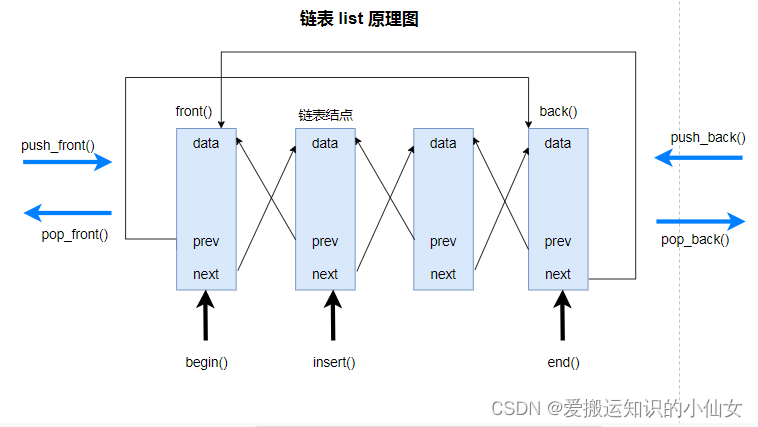10 STL-list
重新系统学习c++语言,并将学习过程中的知识在这里抄录、总结、沉淀。同时希望对刷到的朋友有所帮助,一起加油哦!
生命就像一朵花,要拼尽全力绽放!死磕自个儿,身心愉悦!
写在前面,本篇章主要介绍STL中常用容器list。
1.1 list基本概念
功能:将数据进行链式存储。
链表list 的数据存储:是非连续的,数据元素的前后顺序是通过链表中的指针链接来 实现的。
链表的组成: 由一系列的结点组成。
结点的组成:
- 一个数据域,用来存储数据元素。
- 一个指针域,用来存储上一个和下一个结点地址。
链表是一个双向循环链表。 因为指针域可以存储上一个和下一个结点地址,第一个结点的的prev指针指向的是最后一个结点的地址,最后一个结点的next指针指向的第一个结点的地址,使得头尾结点可以相互访问。
链表的迭代器:
由于链表的存储方式不是连续的内存空间,因此链表中的迭代器只支持前移和后移,属于双向迭代器。不是随机迭代器。
list的优点:
- 存储不是连续的,采用动态存储分配,不会造成内存浪费和溢出。
- 插入和删除非常方便,修改指针域即可,不需要移动大量元素。
- 插入和删除都不会造成原有list迭代器失效,这在vector不成立。
list的缺点:
- 灵活,但是空间和时间消耗大。(指针域造成空间消耗大)(在遍历时需要根据指针来判断下一个结点,时间消耗大)
1.2 list构造函数
函数原型:
- list<T> lst; //list采用采用模板类实现,对象的默认构造形式:
- list(beg, end); //构造函数将[beg, end)区间中的元素拷贝给本身。
- list(n, elem); //构造函数将n个elem拷贝给本身。
- list(const list& lst); //拷贝构造函数。
示例:
1.3 list赋值和交换
函数原型:
- size(); //返回容器中元素的个数empty(); //判断容器是否为空
- resize(num); //重新指定容器的长度为num,若容器变长,则以默认值填充新位置。//如果容器变短,则末尾超出容器长度的元素被删除。
- resize(num, elem); //重新指定容器的长度为num,若容器变长,则以elem值填充新位置。//如果容器变短,则末尾超出容器长度的元素被删除。
示例:
1.4 list大小操作
函数原型:
- size(); //返回容器中元素的个数
- empty(); //判断容器是否为空
- resize(num); //重新指定容器的长度为num,若容器变长,则以默认值填充新位置。//如果容器变短,则末尾超出容器长度的元素被删除。
- resize(num, elem); //重新指定容器的长度为num,若容器变长,则以elem值填充新位置。//如果容器变短,则末尾超出容器长度的元素被删除。
示例:
输出:
0 1 2 3 4
l1 不为空
l1 size(): 5
0 1 2 3 4 0 0 0 0 0
0 1 2 3 4 0 0 0 0 0 6 6 6 6 6 6 6 6 6 6
0 1 2
1.5 list插入和删除
函数原型:
- push_back(elem); //在容器尾部加入一个元素
- pop_back(); //删除容器中最后一个元素
- push_front(elem); //在容器开头插入一个元素
- pop_front(); //从容器开头移除第一个元素
- insert(pos, elem); //在pos位置插elem元素的拷贝,返回新数据的位置。
- insert(pos, n, elem); //在pos位置插入n个elem数据,无返回值。
- insert(pos, beg, end); //在pos位置插入[beg,end)区间的数据,无返回值。
- clear(); //移除容器的所有数据
- erase(beg, end); //删除[beg,end)区间的数据,返回下一个数据的位置。
- erase(pos); //删除pos位置的数据,返回下一个数据的位置。
- remove(elem); //删除容器中所有与elem值匹配的元素。
示例:
1.6 list数据存取
函数原型:
- front(); //返回第一个元素
- back(); //返回最后一个元素
示例:
1.7 list反转和排序
函数原型:
- reverse(); 反转链表
- sort(); 链表排序,默认升序
示例:
1.8 list排序案例
需求描述:
自定义person类,包含姓名、年龄、升高属性。
排序规则,按照年龄升序,若年龄相同,按照身高降序。
示例:





【推荐】国内首个AI IDE,深度理解中文开发场景,立即下载体验Trae
【推荐】编程新体验,更懂你的AI,立即体验豆包MarsCode编程助手
【推荐】抖音旗下AI助手豆包,你的智能百科全书,全免费不限次数
【推荐】轻量又高性能的 SSH 工具 IShell:AI 加持,快人一步
· winform 绘制太阳,地球,月球 运作规律
· 震惊!C++程序真的从main开始吗?99%的程序员都答错了
· 【硬核科普】Trae如何「偷看」你的代码?零基础破解AI编程运行原理
· 超详细:普通电脑也行Windows部署deepseek R1训练数据并当服务器共享给他人
· AI与.NET技术实操系列(五):向量存储与相似性搜索在 .NET 中的实现